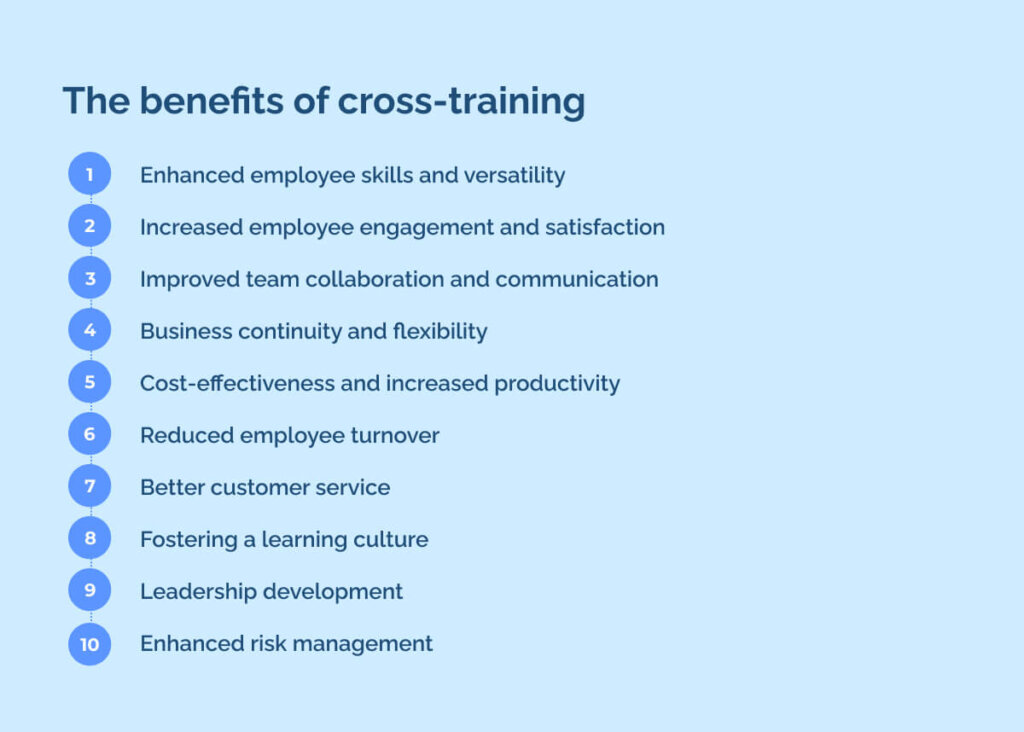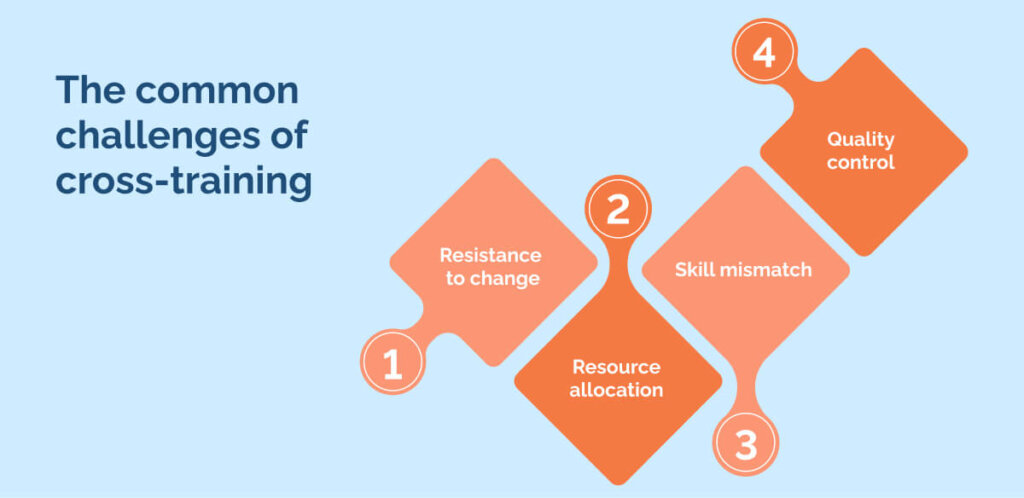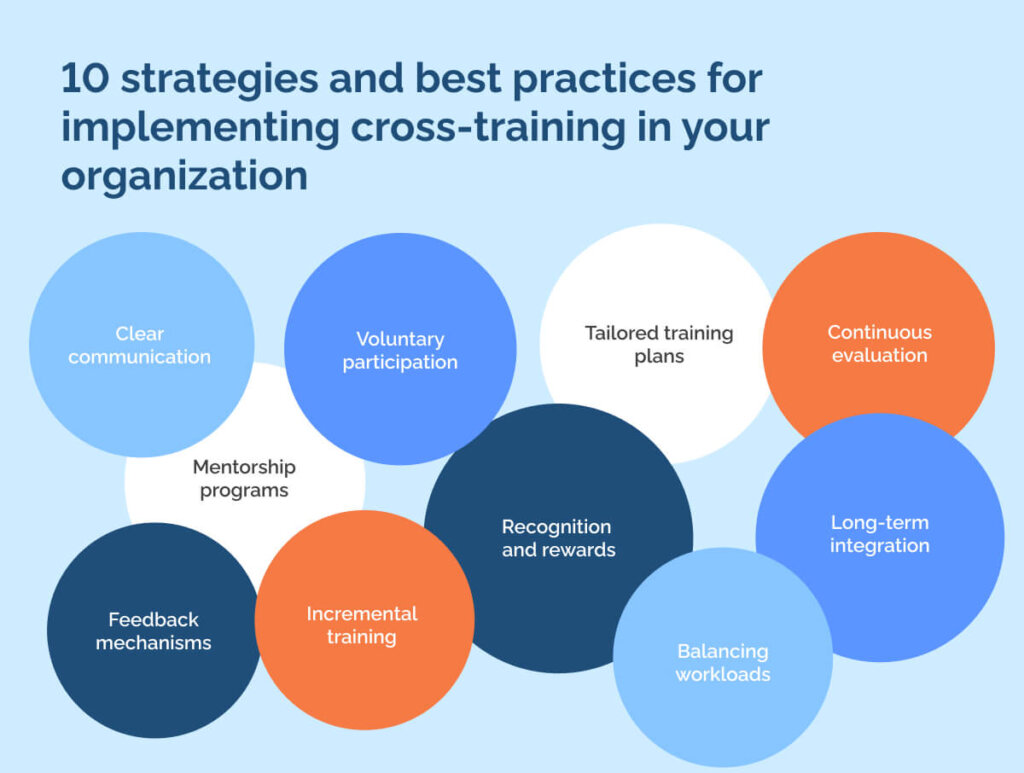
When you’re leading a business, you’re constantly seeking ways to enhance the efficiency and adaptability of your workforce.
Cross-training, a strategy where you train your employees in multiple roles and skills within your organization, emerges as a powerful tool to achieve this.
It’s more than just an employee training technique; it’s a paradigm shift in how you develop and deploy your human resources.
In today’s fast-paced and ever-changing business environment, the importance of cross-training cannot be overstated. It equips your team not only with a broader skill set but also with a deeper understanding of the organization’s operations.
This multifaceted approach to employee development fosters business resilience and a more flexible workforce, capable of stepping in and out of various roles as needed. Furthermore, a 2023 study by IRJMETS showed that cross-training improves employee job satisfaction, sense of empowerment, and contributes to the overall productivity and success of a company
In this article, we’ll explore the ten key benefits of cross-training employees.
From enhancing their skills and versatility to improving team collaboration, and from ensuring business continuity to increasing overall employee productivity, the advantages are substantial. By the end of this article, you’ll have a comprehensive understanding of why cross-training is vital for modern businesses and how to create a cross-functional team.
What is cross-training?
Cross-training, in the context of employee development, is a strategic approach where you train your employees to perform multiple roles within your organization.
Unlike traditional training methods that focus on enhancing skills specific to an employee’s current role, cross-training broadens their capabilities across different functions and departments.
This versatility not only enhances your team’s skill set but also provides a comprehensive understanding of your business operations from multiple perspectives.
What sets cross-training apart from other training methods is its holistic approach. While specialized training deepens expertise in a particular area, cross-training broadens the skill horizon, creating a more flexible and adaptable workforce.
It’s akin to building a team of multi-skilled players who can adapt and switch roles as the game changes, rather than being confined to a single position.
What are the benefits of cross-training?

Cross-training offers a multifaceted approach to skill enhancement and versatility. It enables employees to acquire a diverse set of skills and knowledge, fostering a more adaptable and innovative workforce capable of handling various challenges and roles. Here are the top ten benefits of cross-training employees.
1. Enhanced employee skills and versatility
Cross-training significantly broadens the skill sets of your employees, transforming them into versatile assets for your organization.
This approach allows team members to develop competencies beyond their primary roles, fostering a workforce that is both skilled and adaptable.
For instance, a marketing specialist trained in sales techniques can better understand customer perspectives, leading to more effective marketing strategies.
Imagine your employees, post cross-training, fluidly moving between roles. A project manager with a grasp of finance can manage budgets more effectively, while a customer service representative with technical training can resolve issues without escalating them.
This versatility not only leads to individual performance improvement but also streamlines team dynamics, as employees gain a holistic understanding of various functions. This breadth of skills, nurtured through cross-training, ensures that your team is well-equipped to meet diverse challenges, making your organization more resilient and agile.
2. Increased employee engagement and satisfaction
Cross-training plays a pivotal role in boosting job satisfaction and employee engagement.
When you invest in diversifying the skills of your team, it conveys a message of trust and value, significantly enhancing their sense of belonging and commitment to your organization. Learning new skills not only breaks the monotony of routine work but also stimulates intellectual curiosity and professional growth.
The psychological impact of this expanded skill set is profound. Employees feel more empowered and confident as they acquire new competencies, leading to a more fulfilling employee experience. This sense of achievement and progress is a key driver of job satisfaction.
Additionally, the opportunity to engage in varied tasks and roles reduces burnout and keeps motivation levels high. As a result, you’ll notice a more enthusiastic, committed, and satisfied workforce, ready to contribute creatively and effectively to your organization’s goals. According to research from Mckinsey in 2021, companies that are leaders in employee experience see a 40% increase in discretionary effort from their employees.
3. Improved team collaboration and communication
Cross-training is a catalyst for enhanced collaboration and communication within your teams.
By understanding the roles and responsibilities of their colleagues, employees develop a deeper appreciation of different functions within the organization. This insight fosters empathy and a sense of camaraderie, as team members recognize the challenges and contributions of different departments.
Crucially, cross-training breaks down silos that often exist in the workplace.
When employees are trained in multiple disciplines, they become effective communicators and collaborators, bridging gaps between departments. This interdepartmental understanding encourages a more integrated approach to problem-solving and project management. Employees can communicate more effectively, anticipate the needs of other teams, and work cohesively towards common goals.
As a result, your organization benefits from a more synchronized workforce, capable of agile and informed decision-making, driven by a comprehensive, shared understanding of business operations.
4. Business continuity and flexibility
In times of crisis or high employee turnover, cross-training stands out as a critical element of business continuity planning.
Employees trained in multiple roles can seamlessly step into different positions, ensuring that critical functions remain operational. This adaptability is crucial in mitigating disruptions caused by unexpected absences or shifts in the workforce.
Moreover, cross-training offers unparalleled flexibility in resource allocation and project management.
With a multi-skilled team, you’re equipped to redistribute workloads efficiently, depending on the demands of each project or operational need. This versatility allows for a more dynamic approach to managing tasks and deadlines, as employees are not restricted to a single function.
The ability to adapt quickly to changing circumstances, without the need to recruit additional or specialized staff, positions your organization to respond effectively to market changes and business opportunities, keeping you a step ahead in a competitive landscape.
5. Cost-effectiveness and increased productivity
Cross-training stands as a cost-effective alternative to hiring new staff for different roles.
Training existing employees to cover multiple functions eliminates the expenses associated with recruiting, onboarding, and training new personnel. This approach not only saves on direct hiring costs but also reduces the time it takes for a new employee to reach full productivity.
Moreover, cross-training leads to notable improvements in productivity.
With a more versatile skill set, employees can perform a variety of tasks without the need for handoffs or waiting for specialized personnel. This reduction in downtime and increase in operational flexibility results in a more streamlined workflow.
Employees proficient in multiple areas can also identify efficiencies and innovations that might be overlooked when working in silos. The cumulative effect of these efficiencies significantly boosts overall productivity, making your organization leaner and more agile.
6. Reduced employee turnover
Cross-training significantly impacts employee retention by addressing a key driver of turnover: lack of growth opportunities.
When you provide cross-training, you’re offering your team more than new skills; you’re opening doors to varied career paths within the organization. This sense of potential for upward or lateral movement is a powerful motivator, making employees feel valued and invested in their futures with your company.
Employees who see a clear path for advancement and skill development are less likely to seek opportunities elsewhere. By nurturing their professional growth through cross-training, you’re not only enhancing their capabilities but also reinforcing their commitment to the organization.
The result is a lower turnover rate, as employees remain engaged and loyal, appreciating the investment you’re making in their career development.
In the long run, this stability within your workforce fosters a stronger, more cohesive company culture and saves on the substantial costs associated with frequent hiring and training of new staff.
7. Better customer service
A multi-skilled workforce, honed through cross-training, markedly enhances your organization’s ability to provide comprehensive customer service.
Employees with a broad understanding of various aspects of your business can address customer needs more effectively and provide solutions that are well-informed and holistic.
For instance, consider a customer service representative who has been cross-trained in the technical aspects of your product. This representative can not only handle basic inquiries but also troubleshoot more complex issues, often resolving them without needing to escalate.
Similarly, a salesperson with knowledge of after-sales processes can offer customers more accurate and helpful information, leading to increased satisfaction.
Such versatility in employee skill sets directly translates to improved customer experiences. Customers benefit from quicker, more competent responses and a noticeable reduction in the time taken to resolve their queries or concerns.
This high level of service fosters customer loyalty and often results in positive word-of-mouth, enhancing your company’s reputation and customer base.
8. Fostering a learning culture
Cross-training is instrumental in cultivating a culture of continuous learning and improvement within your organization.
When employees are regularly exposed to new skills and challenges, it fosters a mindset geared towards growth and development. This learning culture not only benefits individual employees but also enhances the overall intellectual capital of your company.
Engaging in diverse training opportunities signals to your team that adaptation and learning are valued and integral to the organizational ethos. This attitude is contagious, encouraging employees to seek out learning opportunities themselves, be it through formal training or informal knowledge sharing with colleagues.
Such an environment is fertile ground for innovation and adaptability.
A workforce that is constantly learning is more likely to think creatively, approach problems from different angles, and adapt to new challenges swiftly. This continuous evolution of skills and knowledge positions your organization to not just respond to changes in the marketplace but to anticipate and lead them.
9. Leadership development
Cross-training serves as an effective tool for identifying and nurturing potential leaders within your organization.
By exposing employees to various roles and departments, you gain insight into their broader capabilities, problem-solving skills, and how they handle different responsibilities. This holistic view is invaluable in spotting individuals with leadership potential.
Furthermore, cross-training prepares employees for higher responsibilities and leadership roles. It equips them with a well-rounded understanding of the business, fostering skills such as strategic thinking, empathy, and adaptability.
These are key traits for effective leadership. Employees who have experienced different facets of the business are better prepared to lead, as they understand the challenges and dynamics of various teams.
This approach to leadership development creates a pipeline of internal talent, ready to step into leadership positions. It ensures a smoother transition and continuity in leadership, as these individuals are already aligned with the company’s culture and goals.
10. Enhanced risk management
A cross-trained workforce significantly enhances your organization’s ability to manage operational risks.
Employees proficient in various aspects of your business can quickly adapt and respond to unforeseen challenges, minimizing disruptions. This flexibility is crucial in maintaining stability during volatile periods.
For example, if a key team member in a critical department is suddenly unavailable, a cross-trained employee can step in, ensuring that essential operations continue without a hitch. This capability is especially valuable in managing risks related to personnel dependency.
Furthermore, employees with diverse skill sets bring different perspectives to problem-solving. This diversity can lead to more robust risk assessment and mitigation strategies, as various angles and potential issues are considered.
In essence, cross-training not only prepares your team to respond effectively to immediate risks but also contributes to a more proactive and comprehensive approach to risk management in the long term.
What are the common challenges of cross-training?

Implementing cross-training programs in your organization can be highly beneficial, but it’s not without its challenges. Understanding these 4 common challenges and adopting our 10 best practices is key to a successful cross-training initiative.
- Resistance to change: Employees might be resistant to learning new roles, particularly if they feel comfortable in their current positions. This resistance can stem from fear of the unknown or a perceived increase in workload.
- Resource allocation: Effective cross-training requires time and resources. Allocating these resources and drawing up a budget is challenging, especially in a busy work environment.
- Skill mismatch: Not all employees are suited for every role. There can be instances where an employee’s aptitudes don’t align well with the new skills being taught.
- Quality control: Maintaining a high standard of work while employees are learning new roles is crucial. There’s a risk of temporary dips in productivity and quality during the training phase.
10 strategies and best practices for implementing cross-training in your organization

Cross-training is increasingly recognized as a strategic asset in today’s dynamic business environment. By embracing the following approaches, you can cultivate a more versatile and resilient workforce, nurturing a culture rich in continuous learning and adaptability.
- Clear communication: Start by clearly communicating the benefits and goals of cross-training to your employees. This transparency helps in alleviating fears and building a positive outlook towards the change.
- Voluntary participation: Encourage voluntary participation rather than making cross-training mandatory. This approach increases enthusiasm and commitment to learning new skills.
- Tailored training plans: Develop personalized training plans that consider each employee’s strengths, weaknesses, and career aspirations. You could ask managers and employees to work together to create a skills matrix. This individualized approach makes training more effective and engaging.
- Mentorship programs: Pair employees with mentors in the areas they’re training in. This one-on-one guidance can enhance the learning experience and provide employees with the support they need.
- Feedback mechanisms: Implement regular feedback sessions. This allows you to gauge the effectiveness of the training and make necessary adjustments.
- Incremental training: Start with small, manageable training modules before progressing to more complex tasks. This gradual approach helps in better absorption of new skills.
- Recognition and rewards: Acknowledge and reward employees who excel in cross-training programs. This can motivate others and create a positive learning environment.
- Continuous evaluation: Regularly evaluate the impact of cross-training on your business operations. Use a training evaluation model to assess both the positive outcomes and areas where adjustments are needed.
- Balancing workloads: Ensure that workloads are balanced and that employees undergoing training are not overwhelmed. This might involve temporarily restructuring responsibilities or bringing in interim support.
- Long-term integration: Finally, integrate the skills acquired through cross-training into your long-term business strategy. This ensures that the effort put into training translates into tangible benefits for your organization.
Maximizing Organizational Success through Effective Cross-Training Strategies
Cross-training employees can transform the dynamics of your workforce and the overall efficiency of your organization.
Throughout this article, we’ve explored the myriad benefits that cross-training brings to the table: from enhancing employee skills and versatility, increasing engagement and satisfaction, to improving team collaboration and communication.
Adopting cross-training strategies in your organization is not just a proactive step toward employee development; it’s a forward-thinking move that positions your company for success in a rapidly evolving business landscape.
If you’re not sure where to start, use an employee training template as a jumping-off point. By investing in the diverse skillsets of your employees and becoming a learning organization, you’re building a robust, adaptable, and innovative workforce, ready to meet the challenges of tomorrow and drive your organization to new heights of success.
WalkMe Team
WalkMe spearheaded the Digital Adoption Platform (DAP) for associations to use the maximum capacity of their advanced resources. Utilizing man-made consciousness, AI, and context-oriented direction, WalkMe adds a powerful UI layer to raise the computerized proficiency, everything being equal.



